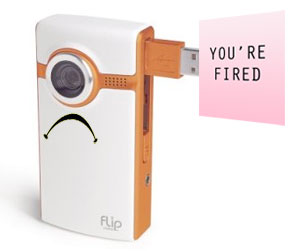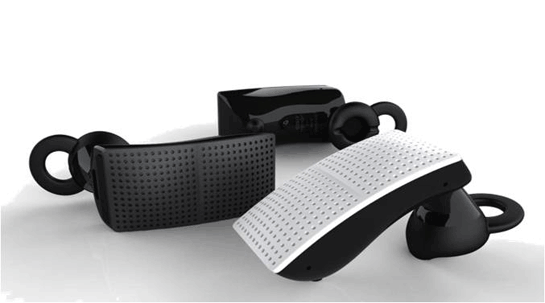The Wall Street Journal is reporting that Cisco and China are involving in a Chinese project to install half a million surveillance cameras in the city of Chongqing. They’ll supposedly be used merely to help prevent crime, but the WSJ has a quote from HP’s Todd Bradley that’s kind of chilling: “It’s not my job to really understand what they’re going to use it for.”
Tag Archives | Cisco
Cisco to Flip Users: Scram!
 How abruptly did Cisco kill the beloved, very popular Flip camcorder? It moved so suddenly that there are still street ads up for the thing, or at least were as of a couple of weeks ago. Some Flip dealers don’t seem to be aware that it’s a dead gadget walking. Heck, it remains the best-selling camcorder on Amazon. Cisco itself will even still happily sell you a Flip.
How abruptly did Cisco kill the beloved, very popular Flip camcorder? It moved so suddenly that there are still street ads up for the thing, or at least were as of a couple of weeks ago. Some Flip dealers don’t seem to be aware that it’s a dead gadget walking. Heck, it remains the best-selling camcorder on Amazon. Cisco itself will even still happily sell you a Flip.
But the company seems to be in a rush to leave its Flip days behind it. The New York Times is reporting that as of yesterday, videos uploaded to FlipShare, the Flip’s video-sharing service, will expire after thirty days. That apparently includes videos already on the service, which means that anyone who uploaded videos to FlipShare that aren’t disposable needs to find a new home for them.
15 comments
A Ghost of Ad Campaigns Back
If you’re bummed out about Cisco axing the Flip, don’t visit San Francisco–ads like this one (in a photo I took yesterday) are a sad reminder of how recently the product appeared to be an extremely viable entity.
No comments
Cius Sees Light
When Cisco announced its business-oriented Cius tablet last June, it looked like one of the more interesting upcoming tablets. It’s had a low profile since, at least compared to RIM’s BlackBerry PlayBook. But now Cisco says it’s beginning to ship Ciuses to customers.
2 comments
Did Flip Have to Die?
The New York Times’ David Pogue has a nice, angry elegy for the Flip camcorder, which Cisco killed earlier this week. David mentions that Cisco recently briefed him on the next-generation Flips, which it had planned to introduce yesterday. I saw ’em too, earlier this month–they had built-in Wi-Fi which permitted both wireless transfers to a computer and live streaming to the Web, and while they weren’t a transcendent advance on earlier Flips, they did look like fun. I wonder what happened to all the new Flips which were manufactured but which won’t ever reach store shelves?
While I’m linking to smart coverage of the Flipocalypse : Michael Mace points out that the emergence of smartphones that do good video didn’t have to render Flip irrelevant (he quotes me at the end, but I’d like his post even if he didn’t).
4 comments
Cisco Axes Flip, Decides That ūmi Isn’t a Consumer Product
 Wow. Networking kingpin Cisco, which had been making a major push into the home in recent years, has announced that it’s dramatically scaling back its consumer efforts. It’s shutting down its Flip camcorder group altogether, shifting the emphasis of its ūmi TV telepresence system (announced just six months ago) from the living room to business use, and refocusing its home networking business “for greater profitability and connection to the company’s core networking infrastructure as the network expands into a video platform in the home.” (I assume that means that it’ll concentrate its Linksys line on bread-and-butter products such as routers, rather than the media streamers and other consumer-electronics gear it’s sometimes experimented with.)
Wow. Networking kingpin Cisco, which had been making a major push into the home in recent years, has announced that it’s dramatically scaling back its consumer efforts. It’s shutting down its Flip camcorder group altogether, shifting the emphasis of its ūmi TV telepresence system (announced just six months ago) from the living room to business use, and refocusing its home networking business “for greater profitability and connection to the company’s core networking infrastructure as the network expands into a video platform in the home.” (I assume that means that it’ll concentrate its Linksys line on bread-and-butter products such as routers, rather than the media streamers and other consumer-electronics gear it’s sometimes experimented with.)
Continue Reading →
3 comments
A (Somewhat) More Affordable Cisco ūmi
 Last October, Cisco unveiled ūmi, a consumer-oriented version of its business telepresence systems. It turned your HDTV into a very high-quality 1080p videophone, and it was neat. But at $599 for the system, plus $24.99 a month for service–times two, since it it assumed you knew at least one other family that owned one–it was too pricey to change the world. (I’ve only seen one in the wild–at the offices of a company that bought two so its Silicon Valley office could communicate with colleagues in Israel.)
Last October, Cisco unveiled ūmi, a consumer-oriented version of its business telepresence systems. It turned your HDTV into a very high-quality 1080p videophone, and it was neat. But at $599 for the system, plus $24.99 a month for service–times two, since it it assumed you knew at least one other family that owned one–it was too pricey to change the world. (I’ve only seen one in the wild–at the offices of a company that bought two so its Silicon Valley office could communicate with colleagues in Israel.)
Cisco made some announcements today that make it at least somewhat more likely that ūmi will show up soon in a living room near you. First, it knocked the price of the original version down from $599 to $499. Maybe more important, it slashed the price of monthly service from $24.99 to a more plausible $9.99. It also says it’s going to release a 720p version that will go for $399 and require less bandwidth. (3.5-Mbps up and down is recommended for the 1080p edition.) And it’ll offer free ūmi clients for Windows PCs and Macs so owners have more people to talk with.
No comments
ūmi: Costli
Eric Savitz of Barrons’ has rounded up Wall Street’s responses to Cisco’s new ūmi home videoconferencing system. Consensus: At $599 for the hardware and $25 a month for unlimited calls, it’s too pricey. Of course, there’s a market for expensive-but-neat gadgets, but after chatting with several Cisco executives at its launch event yesterday, I can’t quite tell if the company is going after well-heeled gizmo nuts for now, or whether it thinks it has something that’ll appeal to the teeming masses right away…
2 comments
A Jawbone for Your Work Phone (and Your Mobile Phone, and Your Tablet)
Back in April, networking kingpin Cisco and Aliph, maker of the stylish and sophisticated Jawbone headset, announced they were working together. The first result of their partnership is being announced today, and it’s a pretty obvious one: a version of Aliph’s Jawbone Icon Bluetooth headset that supports Cisco VoIP business phones.
One comment
Cisco Valet Tries to Make Wi-Fi Drop-Dead Easy
 Can setting up a Wi-Fi network ever be drop-dead easy for non-technical folks? Maybe not, but Cisco gives the problem its best shot with a new brand, Valet, that will co-exist with Cisco’s well known Linksys line, now being positioned as “enthusiast” products. Setting setup aside, Cisco has definitely come up with some nice Wi-Fi management software—but I wish there were a way to sell people Wi-Fi gear without removing the technical information that explains how one product differs from another.
Can setting up a Wi-Fi network ever be drop-dead easy for non-technical folks? Maybe not, but Cisco gives the problem its best shot with a new brand, Valet, that will co-exist with Cisco’s well known Linksys line, now being positioned as “enthusiast” products. Setting setup aside, Cisco has definitely come up with some nice Wi-Fi management software—but I wish there were a way to sell people Wi-Fi gear without removing the technical information that explains how one product differs from another.
At launch, the Valet line consists of three items: the $100 Valet and $150 Valet Plus Wi-Fi routers, and a $100 USB adapter. The somewhat Apple-esque packaging for the Valet router I tried out was covered with aspirational taglines such as “Home wireless made easy” and “Welcome to the new home wireless experience.”
The box was also free of most pesky specs, apart from the Wi-Fi Alliance logo showing certification for 802.11b/g/n. That at least told me that while the Valet does support the fastest Wi-Fi standard, it only supports it on the 2.4ghz band, which in many places is woefully overcrowded by signals from neighboring networks, Bluetooth devices, microwave ovens and some cordless phones.


